Parkinsonia florida, Blue Paloverde
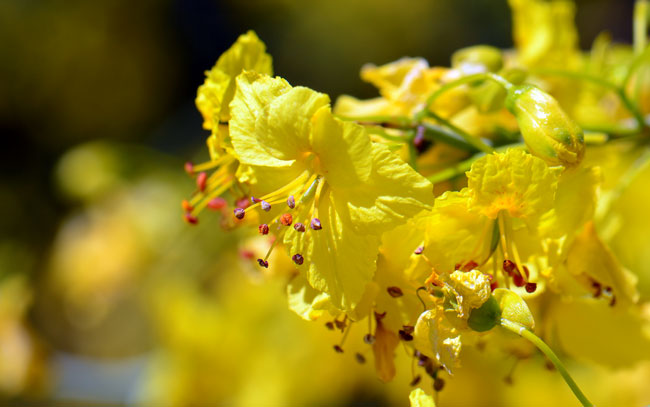 '
'
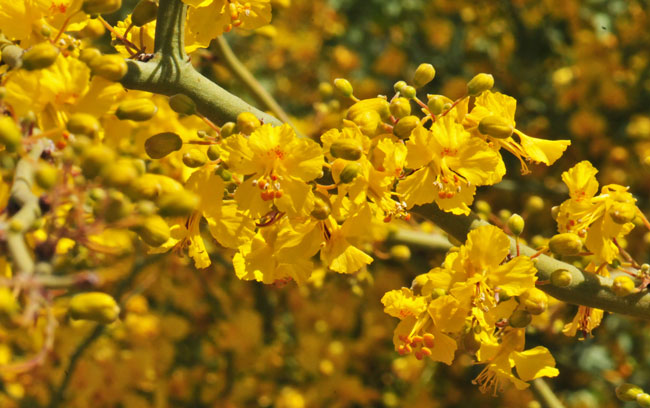
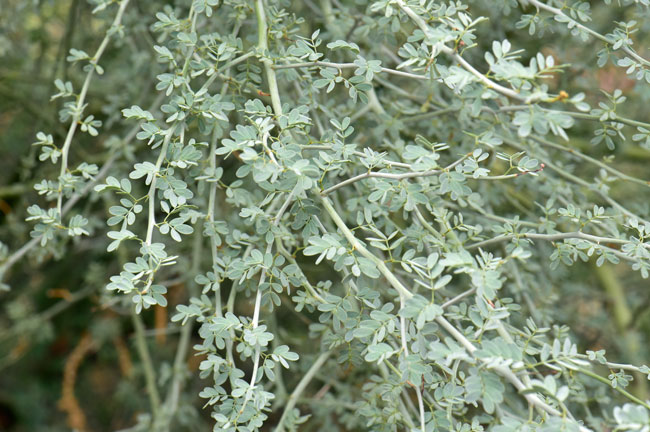
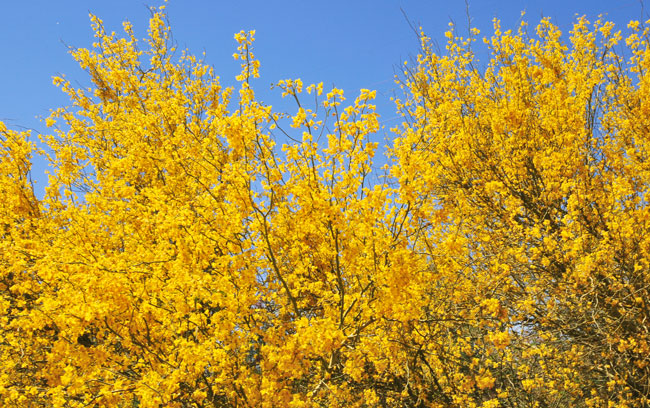
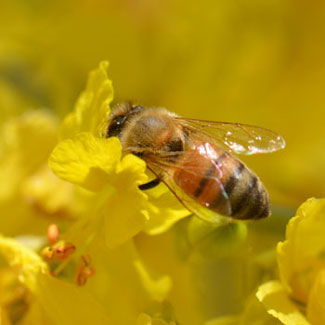
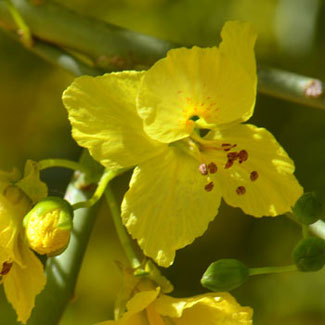
Scientific Name: Parkinsonia florida
Common Name: Blue Paloverde
Also Called: Blue Palo Verde, Blue Palo-Verde; (Spanish: Palo Verde Azul)
Family: Fabaceae or Leguminosae Family
Synonyms: (Cercidium floridum, Cercidium floridum subsp. floridum, Cercidium floridum subsp. peninsulare)
Status: Native
Duration: Perennial
Size: 20 to 32 feet (6 - 10 m) tall.
Growth Form: Blue Paloverde is a tree or large shrub; spiny; trunks, branches and twigs are blue-green are able to photosynthesize; older trunks turn grayish with time.
Leaves: Blue Paloverde leaves are green, few and scattered, they are pinnate, and their leaflets are in 2 to 3 pairs, (as shown in the photo above), very small, mostly absent, often appear after late summer monsoon rainfall.
Flower Color: Blue Paloverde flowers are bright yellow, pea-like; 1 to 2 inches (2.5 - 5 cm) across, the banner or standard petal is also yellow which may distinguish it from other similar Paloverde trees; the fruit is a legume with flattened pods which are not tightly constricted between seeds.
Flowering Season: March to April or May and occasionally again from August to October following summer monsoon rainfall. Blue Paloverde typically blooms a week or two before Yellow Paloverde.
Elevation: Sea level to 4,000 feet (1,219 m), variable throughout its' range.
Habitat Preferences: Common in dry desert washes or bajadas, flood plains and canyons.
Recorded Range: In the United States, Blue Paloverde is found in the southwestern states of Arizona, California and Nevada. It is also native to Baja California and Sonora Mexico. In Arizona it occurs in the central, southern and western parts of the state. In Nevada it is found in the extreme southeast corner and in California in the southeast.
North America & US County Distribution Map for Parkinsonia florida.
North America species range map for Parkinsonia florida:
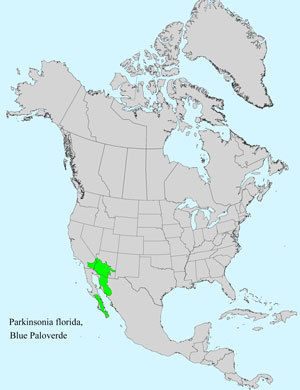
U.S. Weed Information: Unknown
Invasive/Noxious Weed Information: Unknown
Wetland Indicator: Unknown
Threatened/Endangered Information: In Arizona, Blue Paloverde, Parkinsonia florida, is "Salvage Assessed, Harvest Restricted" (A permit from the Department of Agriculture is necessary to transport this species off private property.)
Genus Information: In North America, USDA Plants Database lists 4 species and 6 accepted taxa overall for Parkinsonia. Worldwide, World Flora Online includes 13 accepted species names for Parkinsonia.
The genus Parkinsonia was published in 1752 by Carl Linnaeus, (1707-1778).In the Southwestern United States: Arizona, California and Texas each have 3 species of Parkinsonia, Nevada has 2 species and New Mexico and Utah each have 1 species. Data approximate, subject to revision.
Comments: The Blue Paloverde is the state tree of Arizona and was also named the "City tree" of South Miami, Florida. Blue Paloverde has been commonly cultivated as an ornamental plant and often serves as a focal plant in many large desert landscaped areas in central and southern Arizona. Both Blue and Yellow Paloverde trees are very slow growers. A new hybridized Paloverde has been developed by nurseries and these trees are more commonly planted in desert landscapes.
Blue Paloverde is native to the Sonoran Desert and is co-dominant with with Creosote (Larrea), Desert Ironwood (Olneya), Saguaro (Carnegiea), Ocotillo (Fouquieria) and Mesquite (Prosopis) occurring primarily in valleys and washes. Most of the trees bloom in unison in beautiful bright yellow flowers.
As with many other large desert trees and shrubs, Blue Paloverde trees provide shelter and protection for young plants including saguaro cacti and thus is often called a “nurse plant”.
Blue Paloverde was first described and collected near Hermosillo, in Sonora, Mexico in 1830 by Thomas, Coulter, (1793-1843).
Blue Paloverde was first described and collected near Hermosillo, in Sonora, Mexico in 1830 by Thomas, Coulter, (1793-1843) and named in 1852 by George Bentham, (18800-1884) and Asa Gray, (1810-1888).
Blue Paloverde is superficially similar in appearance to both Jerusalem Thorn, Parkinsonia aculeata and Yellow Paloverde, Parkinsonia microphylla.
Key distinguishing features that are generally, not always accurate separating 3 similar species of local Paloverde trees is the color of the large banner or standard petal as follows;
Blue Paloverde provides forage for livestock throughout the year and their fruit, stems and leaves are eaten. Game mammals including mule deer and bighorn sheep also feed on the stems and leaves and wild burros take advantage of all parts of the Blue Paloverde. Seeds and seed-pods are readily eaten by ground birds and small mammals during summer and fall months.
Blue Paloverde have evolved over thousands of years and are known pollinators of native bees, beetles and flies.
The species epithet “florida” is a reference to one of its' first documented locations.
The common name “Paloverde” comes from two Spanish words “Palo” meaning “stick” or “club” and “verde” meaning “green”; and together, greenstick, a reference to their branches and stems.
See complete listing of ethno-botanical uses at Native American Ethnobotany, University of Michigan, Dearborn.

